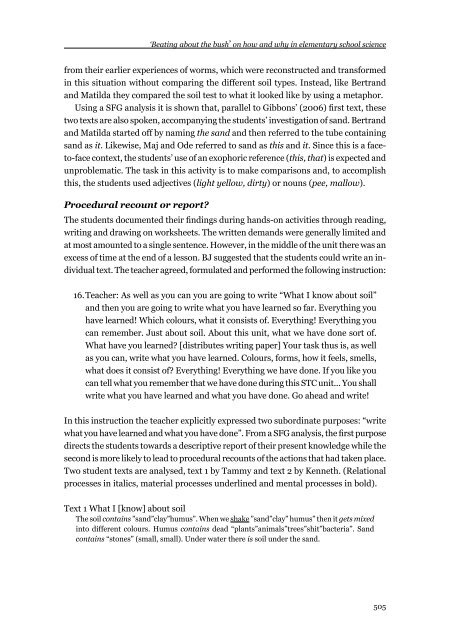Download issue - Lärarutbildning - Umeå universitet
Download issue - Lärarutbildning - Umeå universitet
Download issue - Lärarutbildning - Umeå universitet
You also want an ePaper? Increase the reach of your titles
YUMPU automatically turns print PDFs into web optimized ePapers that Google loves.
‘Beating about the bush’ on how and why in elementary school science<br />
from their earlier experiences of worms, which were reconstructed and transformed<br />
in this situation without comparing the different soil types. Instead, like Bertrand<br />
and Matilda they compared the soil test to what it looked like by using a metaphor.<br />
Using a SFG analysis it is shown that, parallel to Gibbons’ (2006) first text, these<br />
two texts are also spoken, accompanying the students’ investigation of sand. Bertrand<br />
and Matilda started off by naming the sand and then referred to the tube containing<br />
sand as it. Likewise, Maj and Ode referred to sand as this and it. Since this is a faceto-face<br />
context, the students’ use of an exophoric reference (this, that) is expected and<br />
unproblematic. The task in this activity is to make comparisons and, to accomplish<br />
this, the students used adjectives (light yellow, dirty) or nouns (pee, mallow).<br />
Procedural recount or report?<br />
The students documented their findings during hands-on activities through reading,<br />
writing and drawing on worksheets. The written demands were generally limited and<br />
at most amounted to a single sentence. However, in the middle of the unit there was an<br />
excess of time at the end of a lesson. BJ suggested that the students could write an individual<br />
text. The teacher agreed, formulated and performed the following instruction:<br />
16. Teacher: As well as you can you are going to write “What I know about soil”<br />
and then you are going to write what you have learned so far. Everything you<br />
have learned! Which colours, what it consists of. Everything! Everything you<br />
can remember. Just about soil. About this unit, what we have done sort of.<br />
What have you learned? [distributes writing paper] Your task thus is, as well<br />
as you can, write what you have learned. Colours, forms, how it feels, smells,<br />
what does it consist of? Everything! Everything we have done. If you like you<br />
can tell what you remember that we have done during this STC unit... You shall<br />
write what you have learned and what you have done. Go ahead and write!<br />
In this instruction the teacher explicitly expressed two subordinate purposes: “write<br />
what you have learned and what you have done”. From a SFG analysis, the first purpose<br />
directs the students towards a descriptive report of their present knowledge while the<br />
second is more likely to lead to procedural recounts of the actions that had taken place.<br />
Two student texts are analysed, text 1 by Tammy and text 2 by Kenneth. (Relational<br />
processes in italics, material processes underlined and mental processes in bold).<br />
Text 1 What I [know] about soil<br />
The soil contains ”sand”clay”humus”. When we shake ”sand”clay” humus” then it gets mixed<br />
into different colours. Humus contains dead “plants”animals”trees”shit”bacteria”. Sand<br />
contains “stones” (small, small). Under water there is soil under the sand.<br />
505

















